

















| |
Chapter Six:
Chart Your Course, But Sail With the Winds
|
|
|
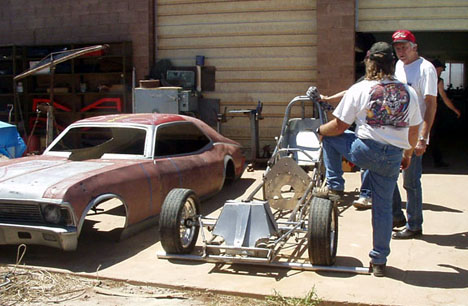
Earl Watts and Ron Miller hash over
just what kind of a foolish person would want to
undertake building a nitro-powered funny car.
|
Sunday morning, we headed north
on I-17 to Flagstaff for breakfast, then east on I-40 to
Winslow. It was exciting to be finally going to touch the body
and chassis. I hoped to spend a concerted amount of time with
Chris Stinson and really get a lot done.
But, I was also warned that it
was possible that the entire town of Winslow had been invited to
stop by and see the weirdo who was building a funny car.
In Emails, Chris was perplexed
about the proper placement of the body on the chassis. While the
wheelbase of both the body and the chassis were both
approximately the same, it was obvious to him that things didn't
line up the way they should.
Early fliptop FCs had their rear
wheels in approximately stock position. Both the driver and
engine were shoved back and the front wheels were moved forward
a few inches. The chassis were built to match individual bodies.
The early models, whether from Logghe, Hardy, or whomever,
usually had the rear axle centerline quite a ways behind the
driver and hanging from coil-over shocks and ladder bars. More
modern, narrower chassis moved the driver's butt back on top
of the pinion changing the dimension drastically between axle
centerline and driver. |
|
|
|
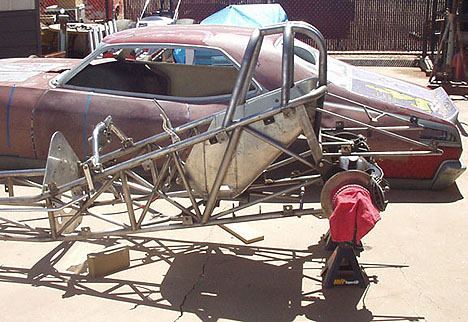
With the tires and wheels OFF the car, it was much
easier to get the body close to where it needs to be.
Note the rectangular uprights that the rear end bolts
to. Rare to find rectangular chromoly in a racecar
today.
|
Another thing about the early
cars was that as horsepower and rear tires increased, the
chassis had to get narrower to make room. An earlier wider
chassis car was unable to handle the wider tires without
modifications. Usually, the low buck teams that would have run
the older cars just radiused the wheelwells and let the bigger
tires stick out.
Another scenario was that a team
rebodied an older chassis. This placed a narrow body on a wide
chassis and forced the car to be jacked up to allow the tires to
clear, radiused wheel wells or a combination of both. There were
even several cars that had major fiberglass wheel bubbles to
clear and cover ever-widening tires.
One famous car that combined
several aspects of the problem was Larry Arnold's Kingfish. It
was originally a Logghe-built 68 vintage Barracuda that become a
70 Cuda. It ran hard, as strong as any car in the country,
and Arnold ran it with radiused wheelwells and tires sticking
out right through the 1971 season. He won the Supernationals at
Ontario that year against all comers. |
|
|
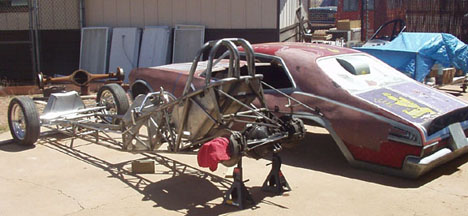
The two major components
seem to have become combatants! They just don't want to
fit together. |
When we pulled in, there were already four or
five folk hanging around Ron's. I was introduced, and
immediately started circling the scene. Several of us grabbed
hold and set the body on the chassis and I could immediately see
the problem(s).
As you can see, the Nova body I have found was
one that was raced until it was long in the tooth past its
prime. The rear wheelwells are radiused as if the body was
originally run on a wider, 68 or 69 chassis; my thoughts are a
Don Hardy. Another strange bit of evidence is an aluminum bubble
in the back window, obviously to clear an addition on the early
cage or the dragster-style hoop of a later chassis. I have no
idea.
When the front wheels were reasonably close to
their proper spot, the rears were way off. When the rear tires
were centered up, the cage hit the body. We moved it back and
forth until we were convinced nothing would work. We took the
body back off and began checking things. We measured. We talked.
We hashed things over. More people stopped by. We discussed
modifications, various alterations.
What we discovered was that the wheelbase of
the chassis was right around 117 inches. The body was closer to
115, and nothing (let me repeat that) NOTHING matched up. |
|
|
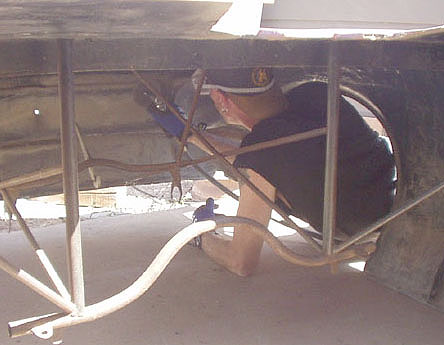
Chris Stinson dove under
the body and whacked out the old front body
"tree" to rid us of a major interference. |
I OK'd Chris to chop the original front
"tree" out of the body in hopes of getting some
clearance and indeed that helped some but not enough. With
virtually every performance car oriented male from Winslow
present, it was easy to lift and replace the body with any whims
we happened to have. But try as we might, we couldn't force
the two major pieces to fit.
The first thought was to shorten wheelbase of
the chassis to match the body. Of course, there were a number of
different ideas on how to successfully accomplish that. Chris
made a couple suggestions figuring he could whittle and weld the
chassis to match exactly what was necessary. Longer torsion bar
arms were discussed to move the axle back and shorten the
wheelbase. Stretching the body was considered, as were moving
the wheelwells.
People came and went. There was even a
fiberglass expert called in, a guy that unfortunately would be
unable to tackle the extensive surgery for at least three
months.
With just a wee bit of fiberglass work in my
history partly on funny cars and the other the constant
repair of a motorcycle I had when I was 16 I pulled Earl
aside and explained to him how I'd add six inches to the Nova's
nose. |
|
|
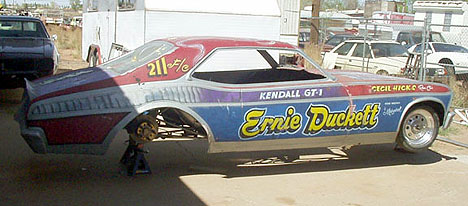
With the tree out of the
way, the body finally sat down and took on the illusion
that things were going to work. Even though it didn't
quite fit, it still began to cool damned cool to me!
|
It was at least another hour of
discussion, with almost everyone adding his or her personal
ideas to the confusion a scene Laurie would later describe
as the "Winslow Sewing Circle." Don't get me wrong,
there were some very good ideas exchanged.
Suddenly, Earl pulled me aside, a
few feet from the unshakable dialogue. He basically said that
since I was so confident that I could do the job, why not just
haul it to his back yard and do it. Why not indeed. We could
head for the house, get the little trailer that carried Laurie's
dragster, come back and get the body the next day. Maybe we won't
need to. I grabbed a tape measure and we checked his Ford
dually. The body would fit inside the sides but was better if
the rear wheelwells were set on the tailgate and the front
bumper on the roof. With our goal set, we grabbed the body and
had it on the truck while the discussers were still mid
sentence. As we tied the body down, we had to answer a lot of
"Whatchagonnado?"s, but between the time Earl and I
said "Let's do it," and the time we merged onto
westbound I-40, barely 15 minutes had transpired.
After a day of indecision and
unknowing, just having done something felt positive. And other
than one tie-strap that insisted on buzzing an eerie F#, the
entire trip was full of what we planned to do the following
morning.
When Laurie "wordsmith"
Watts saw the truck with the body on the back, she suggested it
looked like a "redneck ramptruck." She took a number
of photos of the mating of the FC body and Ford truck. |
|
|
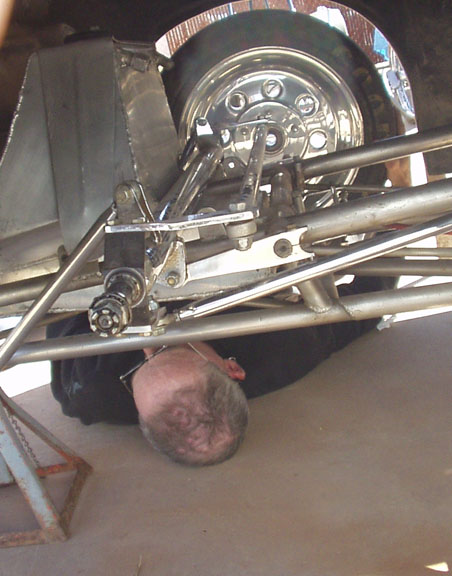
Chris spent some of his
time on his back checking to see what exactly our
interference problems were. No work has been done to the
chassis itself -- yet. That's real torsion bar, straight
axle and tank, exactly the way they came. I still have
no clues as to who built the chassis. There are no
numbers or identifying marks at all.
|
The following morning, Earl and I
headed to several spots around Camp Verde.
The first was to a guy we'd
heard was an out of work body and fender man and races
motorcycles on the side. He was home and was interested in the
project and even said he could do it. However, he'd just
accepted a job repairing cars for the school district. So, we
checked out his bikes and listened to his ideas on how to
stretch the body. He also tipped us to another person that might
be able to help.
Less than a mile away lives one
of the most colorful characters I met that weekend. We were told
that "Kirk" Kirkendall had been around fiberglass
since before it had been invented. Earl and I found him
wandering around in a field checking out the beginnings of a
crop, and hollering orders at a couple youngsters working there.
After brief introductions, we explained why we'd come to
visit.
"We're workin' on a
funny car," we told him, "and need some advice."
"I'll show you a funny
car," said the aging Mr. Kirkendall, then he untarped a
1924 Dodge Bros. touring car that he'd restored. There was
also a Triumph TR-4, which he insisted his grandkids were crazy
for. He then proceeded to inspect the Nova and point by point
walked us through exactly how to accomplish the task. He then
gave us a tour of his place including a history of some of the
fiberglass projects with which he'd been involved. One was a
sixty-foot boat that he'd stretched ten feet! There were
stories. There were moments. He had a hobby shop that obviously
had seen its share of fiberglass projects. |
|
|
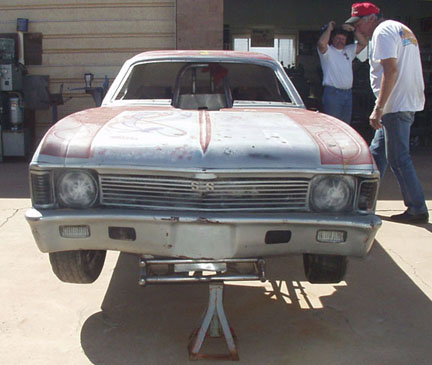
You're not going to
believe me but when I shot this photo, I had tears in my
eyes. A real Chevrolet Nova funny car was evolving right
in front of me! Though a long ways from completion, the
dream had suddenly become far more of a solid reality.
|
I dared to ask, "So, would
you be interested in doing this yourself?" at what I
thought to be an opportune moment. I got the answer, that should
this story ever get to the big screen, could not be written
better.
In the movie, Kirkendall would be
played by Jack Palance. My character, played by Tom Cruise,
would listen intently to his stories, throwing in a few quips
whenever the opportunity arose. Following the well-placed
question, "So, would you be interested in doing this
yourself?" the answer came, exactly the way
"Kirk" had delivered it.
"I'm eighty-years old,
son," Palance would say, following script and direction to
the letter, "Why would I want to do that?"
Tom and Bill Bob Thornton,
playing Earl, look at each other with knowledge that they'd
been put down by the best, bid their adieus, crawl back in the
truck and head for the next stop. |
|
|
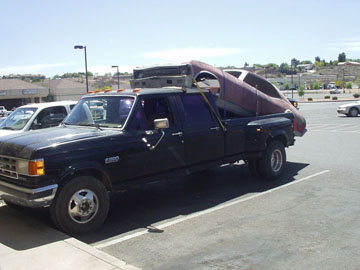
And there is the handiest way to move a funny car
body! That is, if the body in question is very narrow
and you don't need to worry about paint on either the FC
or the truck. In this case, the Watts' Ford was a work
truck so there is no cause for alarm for scratching the
inside of the bed.
|
What really happened was that I
asked if he could help and advise as necessary and
"Kirk" said he'd help out with anything we needed.
In fact, he volunteered to help do the finish work after we got
it roughed.
Earl drew a map so Mr. Kirkendall
could find the Watts estate, and we headed for an 11am
appointment at Quintus Marine.
According to the operations
manager, Kevin, Quintus indeed once built boats of all types and
sizes, and the nautical name had survived. They were fully
spooled up on a government contract building helicopter fuel
tanks. Kevin walked us through the place and after inspected the
Nova body, told us that while he couldn't offer physical help,
he volunteered his fiberglass mat and cloth scrap bin. He also
shared that we were welcome to any resin that had gone past the
government-mandated shelf life.
With that, we carried our
precious cargo back to the house, unloaded it and while Earl
bolted a new starter in the truck, I packed. We then discussed a
little more plans for stretching the body. Laurie surprised me
by coming home from work earlier than she'd originally planned
and she and Earl took me cross-town to the shuttle stop. I rode
it in silence to the Phoenix airport, deep in thought about the
next step.
I committed a major faux pas.
There were no pictures of me sitting in the car. But, I had
learned two major lessons. Building a funny car on zero budget
was going to be one major stumbling block after another and it
was going to take a lot of friends. I'd like to thank everyone
that has become involved, especially Laurie, Earl and Chris. |
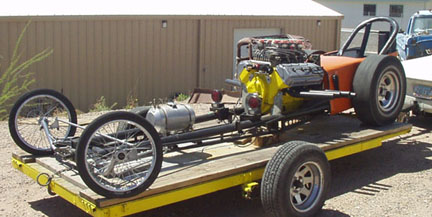
While touring Camp Verde, Earl Watts
showed me what the locals call "the Vodnik."
Purportedly one of Bobby Vodnik's cars from about 1962,
it rides behind a 62 Plymouth and sits out behind the
main performance auto parts outlet there, Ladd Maize's
Carquest. He is 100% into Mopars. |
|
|
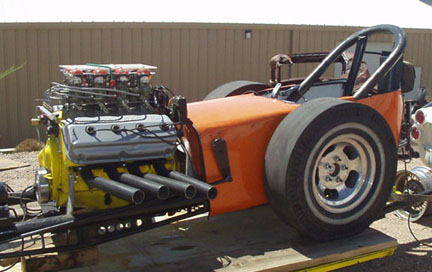
|
|
|
| |
Explore.
Dream.
Discover.
|
